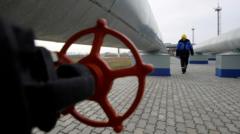Ukraine's gas transit operator Naftogaz has announced the cessation of Russian gas supplies to Europe, marking a pivotal shift in the energy landscape on the continent. This termination coincides with the expiration of a five-year agreement with Russia's Gazprom, as Ukrainian President Volodymyr Zelensky emphasized the nation's refusal to allow Russia to profit from its resources and ongoing conflict. The EU has witnessed a significant reduction in Russian gas imports since the onset of the full-scale invasion of Ukraine in 2022; however, certain eastern European member states remain reliant on these supplies.
Currently, Russian gas constitutes less than 10% of the EU's imports, a dramatic decrease from 40% in 2021. Countries like Slovakia and Austria continue to import reasonable amounts, with Slovakia now becoming the primary entry point for Russian gas into the EU following Ukraine's withdrawal. The Slovakian Prime Minister, Robert Fico, made recent overtures to Russia, threatening to cut off electricity supplies to Ukraine in a move that has drawn accusations from Zelensky of collusion with the Kremlin.
Poland has voiced its readiness to back Ukraine in any potential energy fallout from Slovakian actions, considering Ukraine's precarious energy situation due to ongoing Russian attacks on its infrastructure. Moldova, reliant on gas-fired power supplies fed from Ukraine, faces immediate concerns over power stability; its energy minister has urged citizens to conserve energy amid a state of emergency.
The cessation of the Ukrainian gas transit route signifies the potential end to a historical era of Russian energy supply to Europe, established in 1991. With Ukrainian supplies halted, the TurkStream pipeline through the Black Sea stands as the last avenue for Russian gas export to Europe. Meanwhile, the EU has proactively sought energy diversification strategies, bolstering its capacity through alternative sources such as liquefied natural gas (LNG) from Qatar and the U.S. to reduce reliance on Russian supply.
In response to the impending transition, the European Commission detailed contingency plans to manage supply disruptions, focusing on optimizing existing gas routes and securing resources from other regions, indicating a readiness to cope with the evolving energy crisis resulting from the geopolitical climate in Eastern Europe.
















